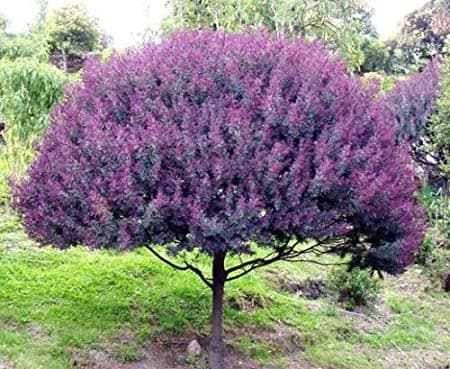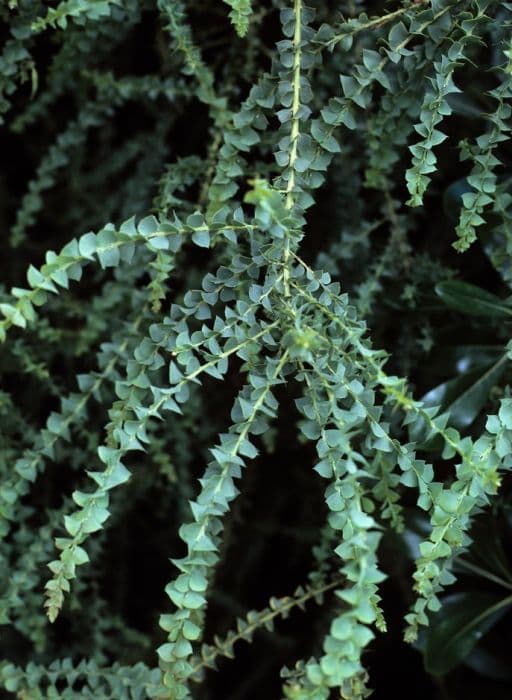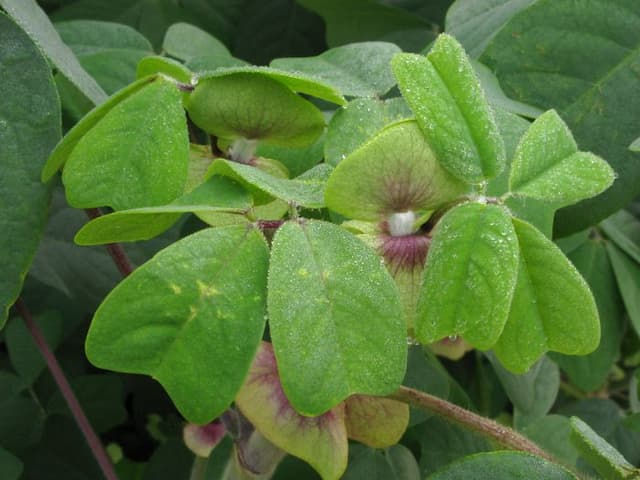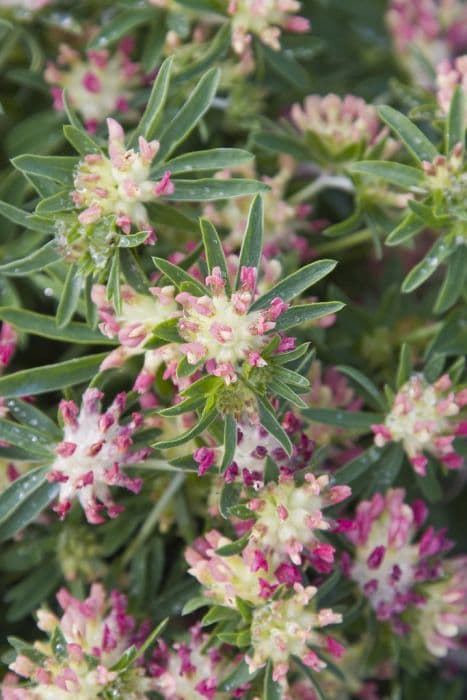Sweet pea Lathyrus odoratus 'Dorothy Eckford'

ABOUT
Sweet pea 'Dorothy Eckford' is a variety that is praised for its striking beauty. It has bright white flowers, which exude a pleasing, sweet fragrance. Each of the flowers typically features a classic sweet pea shape, with a broad, fan-like standard petal at the back and smaller, more delicate wings on the sides. The blossoms are borne on long, slender stems which make them excellent for cutting and arranging in floral displays. The plant itself possesses a climbing habit, with tendrils that eagerly reach out to grasp onto supports, allowing it to elegantly ascend trellises, fences, and other structures in the garden. Its foliage is comprised of pairs of leaflets, bright green in color, which are both delicate and yet robust enough to handle the twining nature of the plant. In essence, Sweet pea 'Dorothy Eckford' is notable for its pure white, sweetly scented flowers and its vigorous climbing habit, all of which combine to create a display that is both eye-catching and redolent in the garden space where it is grown.
About this plant
 Names
NamesFamily
Fabaceae
Synonyms
Sweet Pea, Everlasting Pea, Perennial Pea, Peavine, Vetchling
Common names
Lathyrus odoratus 'Dorothy Eckford'.
 Toxicity
ToxicityTo humans
The plant commonly known as sweet pea, including the variety Lathyrus odoratus 'Dorothy Eckford', has seeds that contain a toxic chemical called lathyrogens. If ingested in large amounts, the seeds can lead to a condition known as lathyrism. Symptoms of lathyrism may include paralysis, labored breathing, convulsions, and potentially fatal neurological damage. Chronic exposure to these toxins can also lead to a disease with gradual onset of muscle weakness and paralysis, mainly affecting the lower limbs.
To pets
Sweet pea, the common name for Lathyrus odoratus 'Dorothy Eckford', is also toxic to pets. Eating the seeds can result in lathyrism in animals, just as it can in humans. Symptoms of poisoning in pets can include lethargy, convulsions, paralysis, and difficulty breathing. Ingesting a large quantity of the seeds could potentially be fatal for pets, so keeping these plants out of reach is important.
 Characteristics
CharacteristicsLife cycle
Annuals
Foliage type
Deciduous
Color of leaves
Green
Flower color
White
Height
6 feet (1.8 meters)
Spread
1 foot (0.3 meters)
Plant type
Climber
Hardiness zones
7
Native area
Mediterranean
Benefits
 General Benefits
General Benefits- Ornamental Value: The sweet pea 'Dorothy Eckford' is prized for its large, white flowers that are highly decorative and add aesthetic appeal to gardens and landscapes.
- Fragrance: This variety is renowned for its sweet, pleasing scent which can enhance the sensory experience of a garden.
- Attracts Pollinators: Sweet peas play a role in supporting local ecosystems by attracting bees, butterflies, and other beneficial insects that pollinate plants.
- Versatility in Garden Design: The plant can be trained to climb up trellises, fences, and arbors or used as a ground cover, providing flexibility in garden design.
- Cut Flowers: The blooms make excellent cut flowers, with their attractive appearance and fragrance, for indoor floral arrangements.
- Easy to Cultivate: Sweet peas, including the 'Dorothy Eckford' variety, are generally easy to grow from seed and care for, making them a good choice for novice gardeners.
- Seasonal Color: They provide a burst of color in the spring and summer, brightening up outdoor spaces during the growing season.
- Screening: When grown on supports, they can create a natural green screen, offering privacy and hiding unsightly views.
- Educational Plant: Growing sweet peas can serve as an educational tool for teaching about plant growth, pollination, and the care of living things.
- Cultural Significance: Sweet peas have a long history of cultivation and are often associated with fond memories and traditions in horticulture.
 Medical Properties
Medical PropertiesThis plant is not used for medical purposes.
 Air-purifying Qualities
Air-purifying QualitiesThis plant is not specifically known for air purifying qualities.
 Other Uses
Other Uses- Cut Flower Arrangements: The sweet pea 'Dorothy Eckford' is often used for cut flower arrangements due to its long stems and fragrant blooms, which can add a delicate scent and touch of elegance to any bouquet.
- Training for Garden Structures: Sweet peas can be trained to climb on garden structures such as trellises, arbors, or fences, providing a vertical element of beauty in garden design.
- Educational Projects: Sweet peas are suitable for educational projects in schools, where students can learn about plant growth, pollination, and the history of plant breeding through hands-on experience.
- Photography Subject: The vibrant whites and gentle shapes of sweet pea flowers make them a popular subject for garden and nature photographers.
- Art Inspiration: Artists may use the sweet pea as inspiration for paintings, illustrations, and floral designs due to their attractive form and color.
- Wedding Decor: Sweet peas are chosen for wedding décor, particularly for spring and early summer weddings, for their soft appearance and fragrance, which can create a romantic atmosphere.
- Memory Gardens: 'Dorothy Eckford' sweet peas can be planted in memory gardens as they are often associated with blissful and nostalgic memories, representing departure or goodbyes.
- Companion Planting: Sweet peas are used in companion planting to enhance the growth of vegetables by attracting beneficial insects and pollinators to the garden.
- Natural Fabric Dyes: The petals of the sweet pea can be used to create natural dyes for fabric, providing a soft, pastel tone to the textiles.
- Theme Gardens: Due to their characteristic scent and appearance, sweet peas can be used in theme gardens, such as Victorian or cottage-style gardens, where they fit the aesthetic and olfactory profile desired.
Interesting Facts
 Feng Shui
Feng ShuiThe Sweet Pea is not used in Feng Shui practice.
 Zodiac Sign Compitability
Zodiac Sign CompitabilityThe Sweet Pea is not used in astrology practice.
 Plant Symbolism
Plant Symbolism- Pleasure: Sweet pea, including the 'Dorothy Eckford' variety, has been associated with pleasure due to its delightful fragrance and appealing flowers, suggesting the enjoyment of life's sweet moments.
- Delicate Pleasures: The sweet pea's delicate appearance often symbolizes tender, fleeting pleasures that must be savored quickly before they fade.
- Goodbye: Sweet peas can represent a farewell or departure, perhaps due to their brief blooming period, signaling a beautiful but temporary presence.
- Thank You for a Lovely Time: The sweet pea's association with pleasant experiences makes it a common choice for expressing gratitude for enjoyable moments spent with others.
- Blissful Pleasure: As an embodiment of pure joy and satisfaction, sweet peas are often symbolic of happiness without concern or care.
 Water
WaterSweet peas require consistent moisture, so water them thoroughly to encourage deep root growth when the top inch of soil feels dry to the touch, typically about once a week. During peak summer heat or in particularly dry climates, you might need to increase the frequency to two or three times per week. Use enough water to saturate the soil to a depth of 6 to 8 inches, which might be about 1 gallon for mature plants, depending on soil type and environmental conditions. Be cautious to avoid overhead watering to prevent diseases; focus water at the base of the plant. During rainy periods, reduce your watering schedule accordingly to prevent overwatering.
 Light
LightSweet peas thrive best in full sunlight, where they can receive at least 6 to 8 hours of direct sun every day. They can tolerate partial shade, especially in hotter climates where some afternoon shade can protect them from the most intense sunlight. Plant them in a spot that is sheltered from strong winds but still receives plenty of daylight to ensure vigorous growth and abundant flowering.
 Temperature
TemperatureSweet peas prefer cooler temperatures and will flourish in conditions where daytime temperatures are between 55°F and 65°F. They can handle short periods of frost and can survive minimum temperatures down to about 25°F, but prolonged exposure to temperatures below freezing or above 75°F can impede growth and flowering. For best results, plant sweet peas in early spring or fall when temperatures are more conducive to their growth habits.
 Pruning
PruningPrune sweet peas to encourage bushier growth and more blooms. Pinch back the tips when plants are 4 to 6 inches tall, which promotes lateral growth. Regularly remove faded flowers and seed pods to encourage continuous blooming. The best time for more extensive pruning and cutting back is after the main blooming season has ended, or in late winter before spring growth begins.
 Cleaning
CleaningAs needed
 Soil
SoilSweet Pea 'Dorothy Eckford' thrives in well-drained, fertile soil with a pH range of 6.0 to 7.5. For best results, use a soil mix consisting of two parts loam, one part peat or compost, and one part sharp sand to ensure proper drainage and fertility.
 Repotting
RepottingSweet Peas, including 'Dorothy Eckford', are generally not repotted as they are annual plants. Instead, sow seeds annually in either late fall or early spring directly in their final growing position or in pots if transplanting.
 Humidity & Misting
Humidity & MistingSweet Pea 'Dorothy Eckford' prefers moderate humidity levels but is adaptable to the humidity conditions commonly found in outdoor garden environments. They do not have specific humidity requirements as long as they are watered appropriately.
 Suitable locations
Suitable locationsIndoor
Ensure bright, indirect light and cool temperatures for indoor growth.
Outdoor
Plant in full sun, use support for climbing, and keep soil moist.
Hardiness zone
2-11 USDA
 Life cycle
Life cycleSweet pea 'Dorothy Eckford' typically begins its life cycle with seed germination when the soil warms in spring; the seeds may be sown directly into the ground where they will grow or started indoors. Upon germination, the seedlings develop a root system and shoot that will eventually bear the trifoliate leaves characteristic of this plant. As it matures, the sweet pea develops climbing tendrils that allow it to grasp onto support structures, essential for its vertical growth habit. The flowering stage occurs in the late spring or summer when the plant produces fragrant, white flowers that attract pollinators for sexual reproduction. Following pollination, the flowers develop into pods, which contain the seeds for the next generation. Finally, as a seasonal annual plant, after seed set, the sweet pea 'Dorothy Eckford' completes its cycle by dying back, leaving the seeds to overwinter and begin the cycle again the following growing season.
 Propogation
PropogationPropogation time
Spring
The Lathyrus odoratus 'Dorothy Eckford', commonly known as the sweet pea 'Dorothy Eckford', is typically propagated through seed sowing. This popular method involves planting the seeds directly into the soil in late winter or early spring, depending on the climate. Prior to sowing, the hard seed coat can be softened by soaking the seeds in water for 24 hours or by gently nicking the seed coat with a file. This process, called scarification, helps to speed up germination by allowing water to penetrate the seed coat more easily. Seeds should be sown 1 inch deep (approximately 2.5 cm) into well-draining soil and spaced about 2 inches apart (about 5 cm). After sowing, keep the soil moist but not waterlogged, and with proper care, seedlings will emerge in 10 to 14 days. Sweet peas prefer cooler temperatures for germination, so it is important not to sow the seeds too late in the season when the soil warms up.









